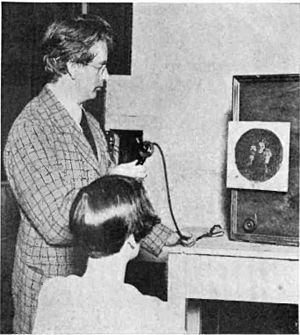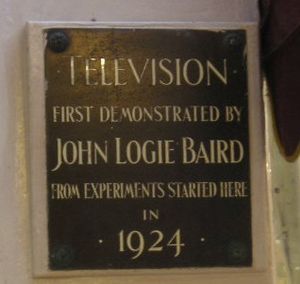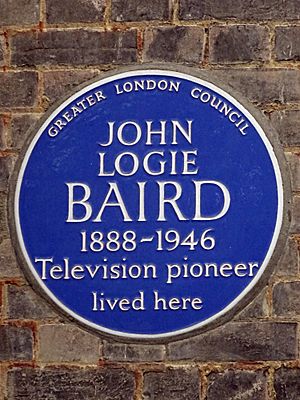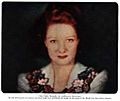John Logie Baird facts for kids
Quick facts for kids
John Logie Baird
FRSE
|
|
|---|---|
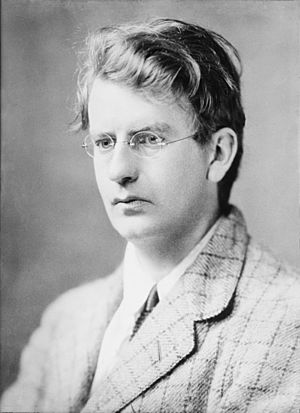
Baird in 1917
|
|
| Born | 13 August 1888 Helensburgh, Argyll and Bute, Scotland
|
| Died | 14 June 1946 (aged 57) Bexhill, Sussex, England
|
| Resting place | Baird family grave in Helensburgh Cemetery |
| Nationality | Scottish |
| Citizenship | British |
| Education | Larchfield Academy, Helensburgh |
| Alma mater | Royal Technical College (now University of Strathclyde), Glasgow |
| Occupation | Inventor businessman |
| Organization | Consulting Technical Adviser, Cable & Wireless Ltd (1941–) director, John Logie Baird Ltd director, Capital and Provincial Cinemas Ltd |
| Known for | One of the inventors of television, including the first colour television. |
| Spouse(s) | Margaret Albu (m. 1931) |
| Children | Diana Baird and Malcolm Baird |
| Parent(s) | Rev John Baird, Minister, West Kirk, Helensburgh Jessie Morrison Inglis |
| Notes | |
|
Member of the Physical Society (1927)
Member of the Television Society (1927) Honorary Fellow of the Royal Society of Edinburgh (1937) |
|
John Logie Baird FRSE (13 August 1888 – 14 June 1946) was a Scottish engineer, innovator, one of the inventors of the mechanical television, demonstrating the first working television system on 26 January 1926, and inventor of both the first publicly demonstrated colour television system, and the first purely electronic colour television picture tube.
In 1928 the Baird Television Development Company achieved the first transatlantic television transmission. Baird's early technological successes and his role in the practical introduction of broadcast television for home entertainment have earned him a prominent place in television's history.
Baird was ranked number 44 in the BBC's list of the 100 Greatest Britons following a UK-wide vote in 2002. In 2006, Baird was named as one of the 10 greatest Scottish scientists in history, having been listed in the National Library of Scotland's 'Scottish Science Hall of Fame'. In 2015 he was inducted into the Scottish Engineering Hall of Fame.
Contents
Early years
Baird was born in Helensburgh, Dunbartonshire, and was the youngest of four children of the Reverend John Baird, the Church of Scotland's minister for the local St Bride's Church and Jessie Morrison Inglis, the orphaned niece of a wealthy family of shipbuilders from Glasgow.
He was educated at Larchfield Academy (now part of Lomond School) in Helensburgh; the Glasgow and West of Scotland Technical College; and the University of Glasgow. While at college Baird undertook a series of engineering apprentice jobs as part of his course. The conditions in industrial Glasgow at the time helped form his socialist convictions but also contributed to his ill health. He became an agnostic, though this did not strain his relationship with his father. His degree course was interrupted by the First World War and he never returned to graduate.
At the beginning of 1915 he volunteered for service in the British Army but was classified as unfit for active duty. Unable to go to the Front, he took a job with the Clyde Valley Electrical Power Company, which was engaged in munitions work.
Television experiments
The development of television was the result of work by many inventors. Among them, Baird was a prominent pioneer and made major advances in the field. Many historians credit Baird with being the first to produce a live, moving, greyscale television image from reflected light. Baird achieved this, where other inventors had failed, by obtaining a better photoelectric cell and improving the signal conditioning from the photocell and the video amplifier.
Baird gave the first public demonstration of moving silhouette images by television at Selfridges department store in London in a three-week series of demonstrations beginning on 25 March 1925.
In his laboratory on 2 October 1925, Baird successfully transmitted the first television picture with a greyscale image: the head of a ventriloquist's dummy nicknamed "Stooky Bill" in a 30-line vertically scanned image, at five pictures per second. Baird went downstairs and fetched an office worker, 20-year-old William Edward Taynton, to see what a human face would look like, and Taynton became the first person to be televised in a full tonal range.
First public demonstrations

On 26 January 1926, Baird repeated the transmission for members of the Royal Institution and a reporter from The Times in his laboratory at 22 Frith Street in the Soho district of London. By this time, he had improved the scan rate to 12.5 pictures per second. It was the first demonstration of a television system that could broadcast live moving images with tone graduation.
He demonstrated the world's first colour transmission on 3 July 1928. The demonstration was of a young girl wearing different coloured hats. Noele Gordon went on to become a successful TV actress, famous for the soap opera Crossroads. That same year he also demonstrated stereoscopic television.
Broadcasting
In 1927, Baird made a signal go over 438 miles (705 km) between London and Glasgow; Baird sent the world's first long-distance television pictures to the Central Hotel at Glasgow Central Station.
Baird then started the Baird Television Development Company Ltd, and in 1928 it made the first transatlantic television transmission, from London to Hartsdale, New York, and the first television programme for the BBC, his television systems were replaced by the electronic television system developed by EMI-Marconi.
Baird did lots of work for the field of electronic television after mechanical systems stopped being used. In 1939, he showed colour television using a cathode ray tube.
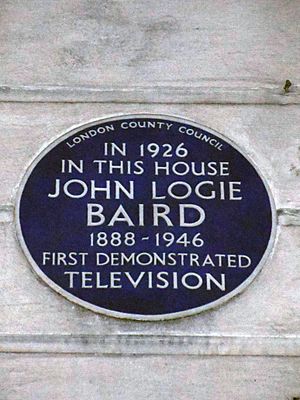
Other inventions
Some of Baird's early inventions did not work. In his twenties he tried to make diamonds by heating graphite and ruined Glasgow's electricity supply. Later Baird made a glass razor which did not get rusty, but it shattered.
Later years
From December 1944, Logie Baird lived at 1 Station Road, Bexhill-on-Sea, East Sussex, immediately north of the station and subsequently died there on 14 June 1946 after suffering a stroke in February. The house was demolished in 2007 and the site is now apartments named Baird Court. Logie Baird is buried with his mother, father and wife in Helensburgh Cemetery, Argyll, Scotland.
Honours and portrayals
Australian television's Logie Awards were named in honour of John Logie Baird's contribution to the invention of the television. Baird became the only deceased subject of This Is Your Life when he was honoured by Eamonn Andrews at the BBC Television Theatre in 1957.
He was played by Michael Gwynn (and also by Andrew Irvine, who played him as a boy) in the 1957 TV film A Voice in Vision and by Robert McIntosh in the 1986 TV drama The Fools on the Hill.
In 2014, the Society of Motion Picture and Television Engineers (SMPTE) inducted Logie Baird into The Honor Roll, which "posthumously recognizes individuals who were not awarded Honorary Membership during their lifetimes but whose contributions would have been sufficient to warrant such an honor".
On 26 January 2016, the search engine Google released a Google Doodle to mark the 90th anniversary of Logie Baird's first public demonstration of live television.
Images for kids
-
This live image of Paddy Naismith was used to demonstrate Baird's first all-electronic colour television system, which used two projection CRTs. The two-colour image would be similar to the later Telechrome system.
See also
 In Spanish: John Logie Baird para niños
In Spanish: John Logie Baird para niños


